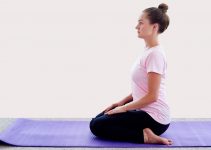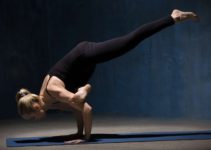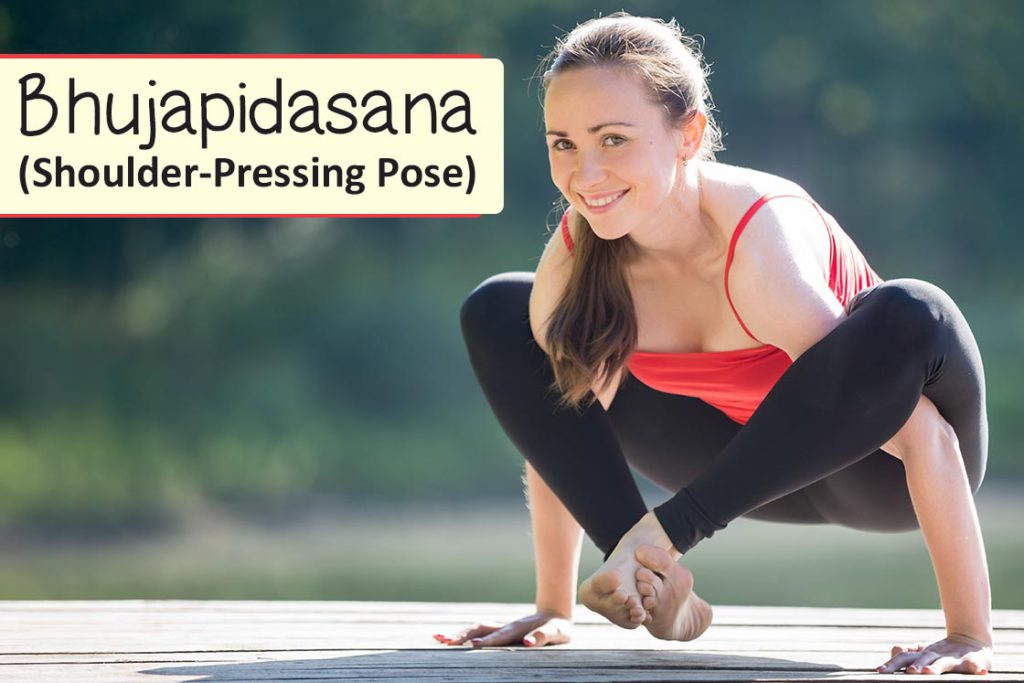
| Sanskrit Pronunciation | Bhujapidasana ((buj-uh-peed-AHS-ah-nuh) |
| Meaning | Bhuja = shoulder / Pida = pressure / asana = pose |
| Pose Type | Seated Back bending pose |
| Pose Level | Advance pose |
| Anatomy | Lower Back muscles, hips, hamstrings, inner thigh, calves, wrist, palms, knees, forearms and shoulder |
| Other Names | Bhujapidasana, Shoulder Press Pose |
Bhujapidasana is an advanced level balancing pose in which shoulders are pressed by the lifted legs. It’s called ‘Shoulder pressing pose’. It helps in strengthening of hands, wrist, shoulder, and torso. Balancing in this pose makes the practitioner-focused and attentive in their day to day struggle that brings productivity in life.
Apart from mentoring physical and mental aspects, Bhujapidasana by setting up a sense of balance in different phases of life promotes emotional upliftment. Therefore, regular practice of this asana creates a healthy environment around the practitioners by influencing their mental, emotional and physical aspects.
Bhujapidasana Meaning
Bhujapidasana is a Sanskrit word where, ‘bhuja’ means ‘shoulder’, ‘pida’ means ‘pressure’, and ‘asana’ means ‘pose’. Hence, in this asana shoulder is being pressurized so that the body can be balanced on both hands.
A simple interpretation of Bhujapidasana is that the legs wrapped around the hands signifies a complicated position of life in which normal people often lose them. The Bhujapidasana mimicking the similar position of limbs, which, when regularly practiced, finds a way through balancing.
So, Shoulder pressing pose is meant to bring the off-track live in a manner or way with which a person establishes himself/herself by going through a tough physical practice. This empowers the inner being to achieve highness, strength, and stability in life.
Practice Guide
Practitioners can follow the given steps to practice Bhujapidasana in a safe manner.
Contraindications of Bhujapidasana
- Pregnant women should avoid doing this asana because the upper thigh might obstruct the stomach. However, menstruating women also avoid practicing as long as the cycle persists.
- Practitioners who have undergone abdominal surgery should refrain from doing Bhujpidasana as it might be disturbing to the incision which is being cured or is yet to be.
- Practitioners with the injuries in wrist, shoulder, elbow, knee, and neck should also avoid practicing. It might have worsened the previous condition if ignored.
- Patients with the condition of cervical spondylitis and high blood pressure should avoid practicing this asana. Balancing could harm your vertebrae and challenging levels might raise blood pressure.
Preparatory Pose
These poses will build shoulder and legs muscles to better grip in Shoulder pressing pose
How To Do Bhujapidasana (Shoulder Pressing Pose) Steps
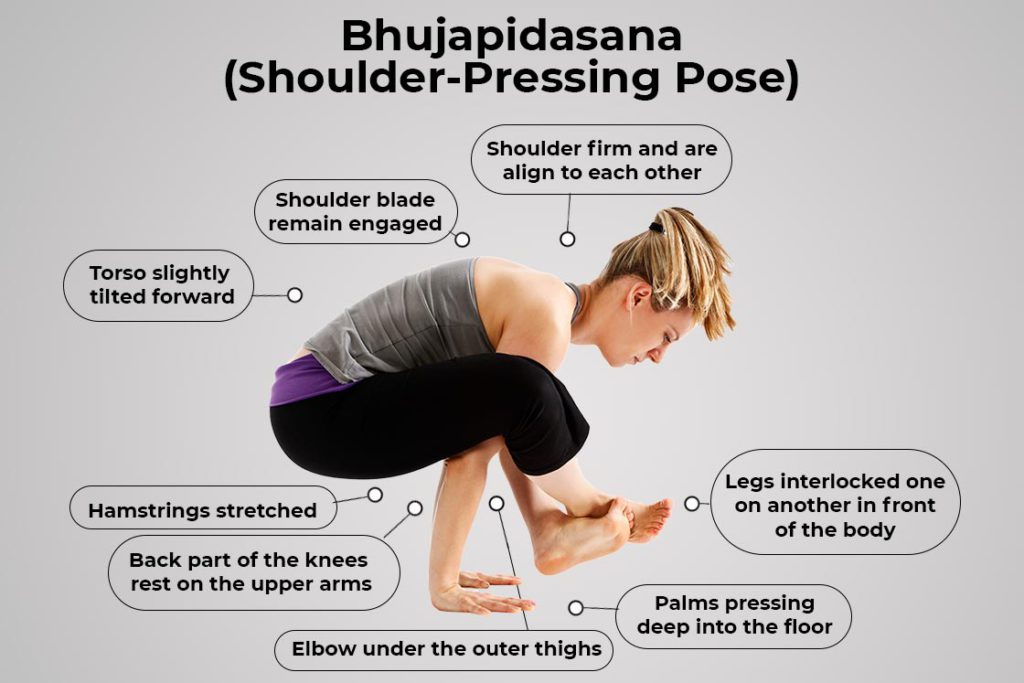
- Begin by coming into tadasana your legs are hips distance apart, head neutral, hands beside the hips and shoulder remain stabilized.
- Now, bend forward to reach the floor by placing your hands right behind your heel. From here, stretch your arms in a way that your upper hand pressed against your calves.
- Now, stabilize your thigh to fit the back portion of your knees into the upper arm by pressing the palms into the floor where fingers point in a forwarding direction.
- Afterward, try to lift off the heel from the floor in order to get a good grip of your thighs on your arms. Now, learn a bit forward to lengthen your back of the torso. It will assist in firming palms better on the floor.
- Now, exhale and activate the core to squeeze legs around the hands in a manner like a snake on the branch. Then, Entangle your foot one on another from the ankle.
- Maintain here as per the comfort and unlock the twisting pattern of hands and legs from each other. Rest your feet on the floor and slowly distribute weight on feet and hands to return back into tadasana and then relax.
Follow Up Poses
- Adho Mukha Svanasana (Downward facing dog pose)
- Uttanasana (Standing Forward Bend)
- Urdhva Mukha Svanasana (Upward facing dog pose)
Precautions
- Practitioners should avoid direct forward bend into the Bhujapidasana if have a condition of the lower back. A slow and steady forward roll might prevent the chances of injuries concerning the practice.
- To adjust the thighs on the region behind the elbow, one should focus on firming the palms in order to keep hands straight and stabilized. Because shifting weight lays heavy stress of bodyweight on hands and lethargy at that time could be injurious.
- Practitioners should not drop their body backward while in the final position of Bhujapidasana. It could result in injuries to the head or spine. Keep your body a little forward and engage your shoulder blade to find the balance in the torso.
Beginners Tips
- Due to the beginning of yoga asanas practice, people who are starting bhujapidasana freshly should know their limits before practice. Because it involves stretching of thigh muscles, which if not considered might cause strain in muscles. So, one should work on flexibility poses before getting into this pose.
- Beginners might face difficulty in holding the bodyweight around the arms stretched fully. One should focus on squeezing the arms into the back pit form on the reduction of angle behind the knee. This will provide the necessary grip to hold the asana for a longer period.
- In the case of balancing the foot placed right in front of you, good core strength is required. Therefore, Beginners with no history of such intense asana practice can build their core muscle by practicing Bhujpidasana or they can entangle them to create a lock-in them. This will provide mutual support for the balancing.
Modifications
By using simple yoga props, balancing or other issues can be overcome easily in Shoulder pressing pose. Modify this pose by following ways;
- Practitioners who are unable to flatten their hand on the floor while going into the pose can take help from the block. By placing blocks under both palms could give necessary support to find the balance in the pose.
- The Bhujapidasana is one of the challenging poses so adjusting your body in a balance is quite a task. So, practitioners with the unavailability of such abilities require to perform this asana stupendously, one should gather strength in their shoulder and forearms by practicing Bakasana and Dandasana and other preparatory poses.
- Practitioners who are finding it difficult the final position of Bhujpidasana can put a block and bolster under the hip bone. It will grant you some freedom for taking a pose for a bit longer than usual.
Variations
There two variation pose of Bhujapidasana – Eka Pada Bhujapidasana and Bakasana
1. Eka Pada Bhujapidasana (One-legged Shoulder pressing pose)
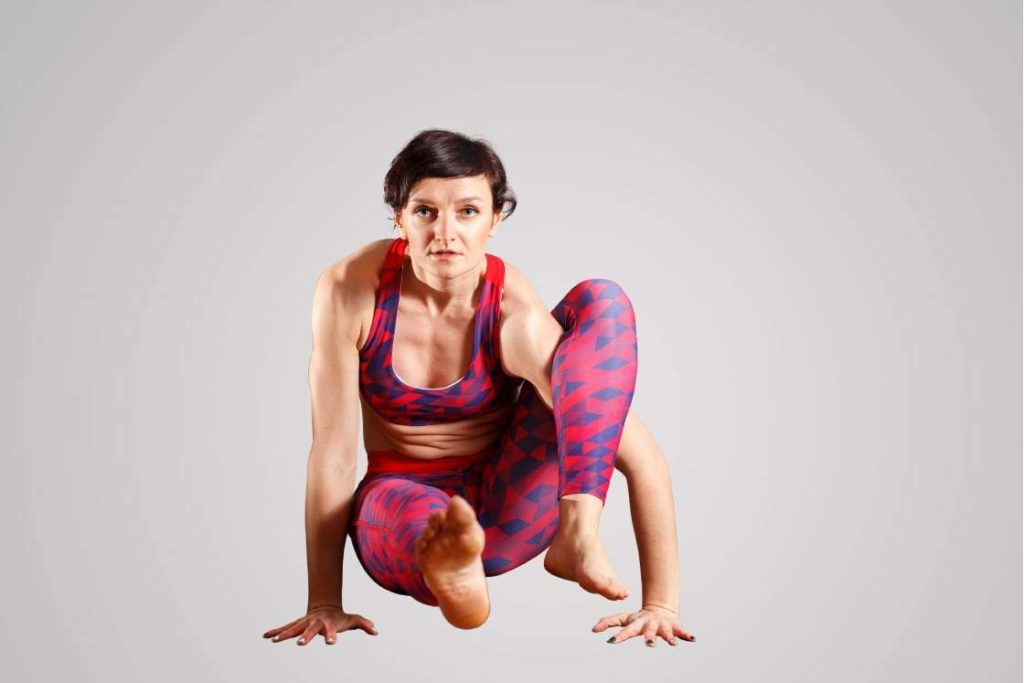
In Bhujapidasana, both of the feet are lifted up from the floor, which is entangled with hands and squeezed under the armpits. Whereas, in Eka Pada Bhujapidasana, both feet remain lifted but one of them is placed on the respective shoulder.
To come into One-legged Shoulder pressing pose, from Dandasana, lift one leg off the ground and place it over your shoulder. Squeeze the lifted leg on your shoulder so it doesn’t slide down. Press your palms firmly on the ground and with inhalation, lift your body off the floor.
In the final position, one leg will remain like dandasana pose and another leg will be on the shoulder – all in the air. Moreover, going deeper, you can place dandasana leg over another leg in lifted position.
2. Bakasana (Crane pose)
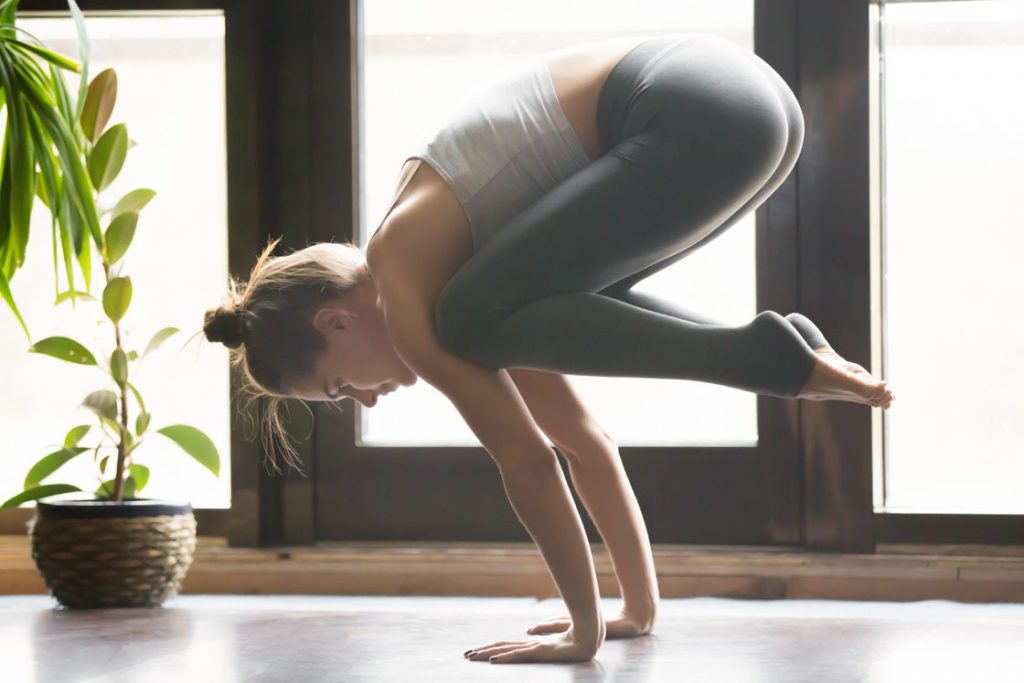
Bakasana involves the placement of knees under the armpit or behind the upper arm and hips raised in an upward direction. While in Bhujapidasana both legs are entangled around the hands along with suction of the back of the knees.
Follow this guide to perform Bakasana (Crane pose).
Therapeutic Benefits
Practicing Bhujapidasana helps in various Therapeutic benefits if one performs it enthusiastically.
1. Reduces Lower Back pain
Usually due to mechanical issues like tearing of muscles, ligaments, which cause damage to the intervertebral disc, compression of nerve roots. Practicing bhujapidasana helps in toning lower back muscles that make them flexible and strong that withstand mechanical injuries. Hence, it helps in reducing lower back pain.
2. Strengthens Wrist and Forearms
Our wrist is complex in possessing various tissues like muscular attachments with so many bones along with the nerves distributed across the concerning region. Practicing this asana helps in the communication of nutrients and oxygen between the musculoskeletal system of hands and blood. This enhances tissue building and bone strengthening in the presence of ample resources. Hence, makes your wrist and forearm stronger.
3. Improves Digestion
Practicing Bhujapidasana improves the blood circulation to the digestive organs that promote the peristalsis motion and make it more effective. Hence, the food travels throughout the alimentary canal quicker than in the condition of Indigestion and constipation. Ultimately, improves digestion.
Benefits of Bhujapidasana (Shoulder pressing pose)
One can get the following benefits by enrolling Bhujapidasana in their schedule of every day.
1. Tones up Abdominal Organs
In Bhujapidasana, there is the active involvement of core muscles as the weight of the entire body is to be maintained on just palms. This pressurizes the abdominal region which on regular practice results in losing fat, toning of internal muscles attached to the organs. In this way, this asana helps in toning internal organs.
2. Develops better physical and cognitive responses
Making foundational support to bear the body weight is quite challenging where the practitioner begins from basic via moderate to intensive physical requirements. This asana due to its challenging nature makes it intensive in approach. It’s evident from research that moderate and intensive physical activities increase working memory and cognitive ability along with faster information processing.
3. Strengthens Upper Body
Our upper body is actively involved in this asana practice, which improves muscular strength by making them adapt to stress for a longer period. Moreover, continuous stress on bones enhance their reabsorption ability towards calcium, which makes them strong and solidifies the structure. Hence, Strengthens the upper body in the long run.
4. Overcomes Stress and Anxiety
Bhujapidasana is an effective approach to tackle stress and anxiety. Practice this asana helps in the reduction of stress hormones like cortisol and adrenaline. However, it also promotes the production of chemicals called endorphins, which are natural painkillers and mood enhancers. This brings a positive attitude to the individual.
5. Improves Blood Circulation
The advancement of Bhujapidasna requires active muscular engagement to keep asana alive for a longer period. In doing so, muscles work harder to resist the pain resulting due to lactic acid accumulation. Hence, to cope with the situation active supply of oxygen and nutrition is required, which can only be done by improving the blood circulation throughout the body.
6. Stimulates Manipura Chakra
Right practice under the guidance of a skilled yoga teacher along with appropriate alignment and breathing technique, this asana helps in the stimulation of Manipura chakra. This further balances the body’s energies regulates the function of digestive organs and pancreas.
Conclusion
The Bhujapidasana practice is an energetic yoga pose, which works on the hand, wrist, forearm, shoulder, thigh, and lower back muscles on a physical scale. This tones up various muscles which helps in the prevention of muscular injuries.
Apart from physical benefits, it calms the mind and proves itself as one of the effective stress buster. Moreover, appropriate practice helps in the stimulation of Manipura Chakra, which further improves the spiritual aspect of the practitioners.
